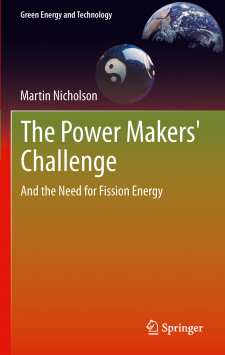 Guest Post by Martin Nicholson. Martin studied mathematics, engineering and electrical sciences at Cambridge University in the UK and graduated with a Masters degree in 1974. He has spent most of his working life as business owner and chief executive of a number of information technology companies in Australia. He has a strong interest in business and public affairs and is a keen observer of the climate change debate and the impact on energy. He is author of Energy in a Changing Climate, as well as an upcoming book on sustainable energy systems, and is the lead author of the 2011 paper in the journal Energy “How carbon pricing changes the relative competitiveness of low-carbon baseload generating technologies“. He wrote a popular post last year on BNC entitled: Cutting Australia’s carbon abatement costs with nuclear power
Guest Post by Martin Nicholson. Martin studied mathematics, engineering and electrical sciences at Cambridge University in the UK and graduated with a Masters degree in 1974. He has spent most of his working life as business owner and chief executive of a number of information technology companies in Australia. He has a strong interest in business and public affairs and is a keen observer of the climate change debate and the impact on energy. He is author of Energy in a Changing Climate, as well as an upcoming book on sustainable energy systems, and is the lead author of the 2011 paper in the journal Energy “How carbon pricing changes the relative competitiveness of low-carbon baseload generating technologies“. He wrote a popular post last year on BNC entitled: Cutting Australia’s carbon abatement costs with nuclear power
This post, and the one to follow, provides an insight into Martin’s new book: The Power Makers’ Challenge: and the need for Fission Energy
———————-
Introduction from the Book Cover
“The Power Makers – the producers of our electricity – must meet the demands of their customers while also addressing the threat of climate change. There are widely differing views about solutions to electricity generation in an emission constrained world. Some see the problem as relatively straight forward, requiring deep cuts in emissions now by improving energy efficiency, energy conservation and using only renewable resources. Many electricity industry engineers and scientists see the problem as being much more involved.
The Power Makers ’ Challenge: and the need for Fission Energy (http://dx.doi.org/10.1007/978-1-4471-2813-7) looks at why using only conventional renewable energy sources is not quite as simple as it seems. Following a general introduction to electricity and its distribution, the author quantifies the reductions needed in greenhouse gas emissions from the power sector in the face of ever increasing world demands for electricity. It provides some much needed background on the many energy sources available for producing electricity and discusses their advantages and limitations to meet both the emission reduction challenge and electricity demand.
By analysing the three main groups of energy sources: renewable energy, fossil fuels and fission energy (nuclear power), readers can assess the ability of each group to meet the challenge of both reducing emissions and maintaining reliable supply at least cost. It is written for both non-technical and technical readers.”
Synopsis
Greenhouse gas (GHG) emissions are changing the landscape for our Power Makers – those good folks that deliver our ultra-reliable electricity supply.
The Power Makers have been largely reliant on fossil fuels for providing abundant and relatively cheap energy and delivering a high standard of living in developed countries. Even so, more than a third of all humanity still has no access to electricity. For those living in less-developed countries, their long-term aspirations are to achieve the same high standard of living enjoyed in the developed world. That means access to abundant cheap energy – and much more of it!
The mainstream scientific consensus is that GHG emissions are the primary cause of recent global warming. In addition, fossil fuels are a finite resource. Continuing to use fossil fuels as our main energy source for generating electricity could lead to both an energy supply and climate disaster: two good reasons for migrating our electricity generation away from fossil fuels.
Technically, economically, socially and politically – we face many challenges in trying to harness non-fossil-fuel energy on a large scale.
The challenge facing our Power Makers is to maintain a reliable, cost effective electricity supply with substantially less emissions. With over 65% of our electricity currently coming from fossil fuels (coal, gas and oil) that produce 44% of the world’s GHG emissions, this is no small challenge. The Power Makers have no choice but to clean up the fossil fuel power plants (or replace them) while maintaining the supply security paramount for both Power Makers and their customers.
Filed under: Emissions, Nuclear, Renewables | 9 Comments »






.png)






